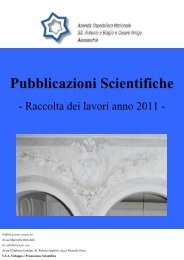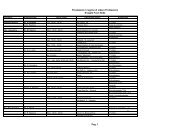Working Paper of Public Health Volume 2012 - Azienda Ospedaliera ...
Working Paper of Public Health Volume 2012 - Azienda Ospedaliera ...
Working Paper of Public Health Volume 2012 - Azienda Ospedaliera ...
You also want an ePaper? Increase the reach of your titles
YUMPU automatically turns print PDFs into web optimized ePapers that Google loves.
<strong>Azienda</strong> <strong>Ospedaliera</strong> Nazionale“SS. Antonio e Biagio e Cesare Arrigo”<strong>Working</strong> <strong>Paper</strong> <strong>of</strong> <strong>Public</strong> <strong>Health</strong>nr. 10/<strong>2012</strong><strong>of</strong> expiratory muscles reduces the magnitude <strong>of</strong> expiratory flow with consequent alteration <strong>of</strong> theexpulsive phase <strong>of</strong> cough and further stagnation <strong>of</strong> secretions and possible pulmonary atelectasis4. PRINCIPLES OF TREATMENTThe main objectives are the treatment <strong>of</strong> cough ineffective and the management <strong>of</strong> bronchialsecretions.4.1 Treatment <strong>of</strong> cough ineffective.The effectiveness <strong>of</strong> cough may be impaired by alterations <strong>of</strong> a single specific phase <strong>of</strong> cough.After a specific evaluation is correct to adopt the most appropriate technique. The rehabilitativeintervention is, therefore, depending on the stage <strong>of</strong> cough in which there is the deficit. The deficitcan affect the phase <strong>of</strong> inspiration, compression and / or expulsion. Phase <strong>of</strong> inspiration: when theCV is less than 1500 ml. In this case the rehabilitative intervention will be aimed at increasing thevolume inspired or pre-cough (Air or Mechanical Stacking In Ex-Sufflator). Compression phase:when the PCEF is less than the PEF, the MEP is greater than 40 and the PCEF is less than 3 litersper second. In this case, the appropriate rehabilitative care will be oriented to the manual cough(Air Stacking) or the use <strong>of</strong> In Ex-Mechanical Sufflator. Ejection phase, when the MEP is lessthan 40 cm H 2 O and when the PCEF is less than 3 liters per second. In this case the treatmentwill be directed to the manual cough assistance (Air Stacking) or the use <strong>of</strong> In Ex-MechanicalSufflator. In case <strong>of</strong> global impairment, both inhalation and exhalation technique may be used,such as re-expansion procedures, assistance coughing procedures or using the Mechanical In Ex-Sufflator. Air Stacking is correctly repeated for 3 cycles daily through facial mask or mouthpiece.Air Stacking, Mechanical In Ex-sufflator and nocturnal Non-Invasive Mechanical Ventilationinduced an higher distensibility and elasticity <strong>of</strong> the chest wall and an increase <strong>of</strong> the MIC(maximum capacity insufflatoria) preventing the atelectasis (3).4.2 Management <strong>of</strong> bronchial secretions.Current recommendations for the management <strong>of</strong> tracheobronchial secretions in patients withrespiratory muscle weakness involving the control <strong>of</strong> posture, physical therapy and use <strong>of</strong> moderntechnology such as the VEST. The control <strong>of</strong> posture through the variation <strong>of</strong> patient position inbed prevents the stagnation <strong>of</strong> secretions in order to facilitate their removal and improve gasexchange in all districts affecting the pulmonary regional distribution <strong>of</strong> pulmonary ventilation. Inaddition to the control <strong>of</strong> posture are important the techniques <strong>of</strong> physiotherapy and clapping.However, these procedures induced fatigue in all patients and there may be important episodes <strong>of</strong>5



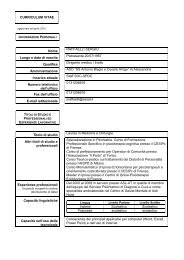
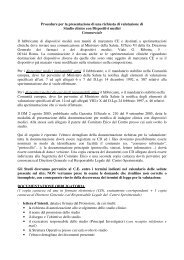

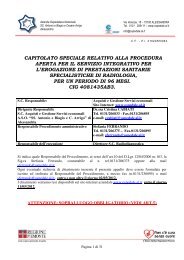
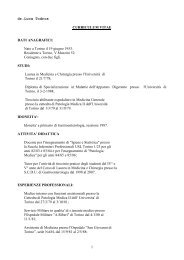
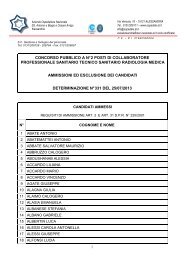

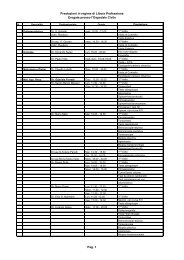


![[torino - 1] lastampa/urc/01 ... 26/10/09 - Azienda ...](https://img.yumpu.com/44058002/1/190x32/torino-1-lastampa-urc-01-26-10-09-azienda-.jpg?quality=85)

